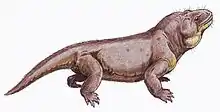1922 in paleontology
Paleontology or palaeontology is the study of prehistoric life forms on Earth through the examination of plant and animal fossils.[1] This includes the study of body fossils, tracks (ichnites), burrows, cast-off parts, fossilised feces (coprolites), palynomorphs and chemical residues. Because humans have encountered fossils for millennia, paleontology has a long history both before and after becoming formalized as a science. This article records significant discoveries and events related to paleontology that occurred or were published in the year 1922.
| |||
|---|---|---|---|
| +... |
Arthropods
Insects
| Name | Novelty | Status | Authors | Age | Unit | Location | Notes | Images |
|---|---|---|---|---|---|---|---|---|
|
sp. nov |
valid |
A geometrid moth |
 Hydriomena? protrita holotype | |||||
Archosauromorphs
Newly named phytosaurs
| Name | Status | Authors | Age | Unit | Location | Notes | Images |
|---|---|---|---|---|---|---|---|
|
Late Triassic (Rhaetian) |
A member of Pseudopalatinae. | ||||||
|
Valid taxon |
Case[4] |
Late Triassic (early Norian) |
A basal member of Leptosuchomorpha. | ||||
|
Valid taxon |
Case[4] |
Late Triassic (early Norian) |
A basal phytosaur | ||||
Newly named dinosaurs
Data courtesy of George Olshevsky's dinosaur genera list.[5]
| Name | Status | Authors | Age | Unit | Location | Notes | Images | |
|---|---|---|---|---|---|---|---|---|
| Alamosaurus[6] | Valid taxon |
early Maastrichtian (late Edmontonian) |
lower Ojo Alamo Formation (Naashoibito Member) |
A North American titanosaur. |
||||
| Dromaeosaurus[7] | Valid taxon |
|
middle Campanian |
|||||
| Erectopus[8] | Valid taxon |
Phosphate-bearing beds of La Penthèive (Mammilatum Zone) |
early Albian |
|||||
| Parasaurolophus[9] | Valid taxon |
|
middle-late Campanian |
Dinosaur Park Formation |
||||
Plesiosaurs
New taxa
|
|||||||||||||||||||||||||||||
Synapsids
Non-mammalian
| Name | Status | Authors | Age | Location | Notes | Images |
|---|---|---|---|---|---|---|
|
Valid |
Amalitski | 255 Millions of years ago | ||||
|
Valid |
Broom | 257 Millions of years ago | ||||
|
Valid |
Amalitski | 254 Millions of years ago | his teeth evolved in saber-toothed feline. | |||
|
Valid |
Hennig | 198 Millions of years ago. | The Last North American Cynodont. | |||
|
Valid |
Amalitski | 264 Millions of years ago. | ||||
References
- Gini-Newman, Garfield; Graham, Elizabeth (2001). Echoes from the past: world history to the 16th century. Toronto: McGraw-Hill Ryerson Ltd. ISBN 9780070887398. OCLC 46769716.
- Cockerell, T. D. A. (1922). "A fossil Moth from Florissant, Colorado". American Museum Novitates (34): 1–2.
- Huene, F. von 1922, Neue Beitrage zur Kenntnis der Parasuchier: Jahrbuch der Preussichen Geologischen Landesanstalt zu Berlin, v. 42, n. 1, p. 59-160.
- Case, E. C., 1922, New reptiles and stegocephalians from the Upper Triassic of Western Texas: Carnegie Institute of Washington, Publication n. 321, p. 1-84.
- Olshevsky, George. "Dinogeorge's Dinosaur Genera List". Archived from the original on 2011-07-15. Retrieved 2008-08-07.
- Gilmore, C.W. 1922. A new sauropod dinosaur from the Ojo Alamo formation of New Mexico. Smithsonian Misc. Collect. 72: pp. 1-9.
- Matthew, W.D. and B. Brown. 1922. The family Deinodontidae with notice of a new genus from the Cretaceous of Alberta. Amer. Museum Nat. Hist. Bull. 46: pp. 367-385.
- Huene, F. von. 1922. Uber einen Sauropoden im oberen Malm des Bemer Jura. Eclogae Geol. Helvetiae 17: pp. 80-94.
- Parks, W.A. 1922. Parasaurolophus walkeri, a new genus and species of crested trachodont dinosaur. Univ. Toronto Stud. (Geol. Ser.) 13: pp. 1-32.






